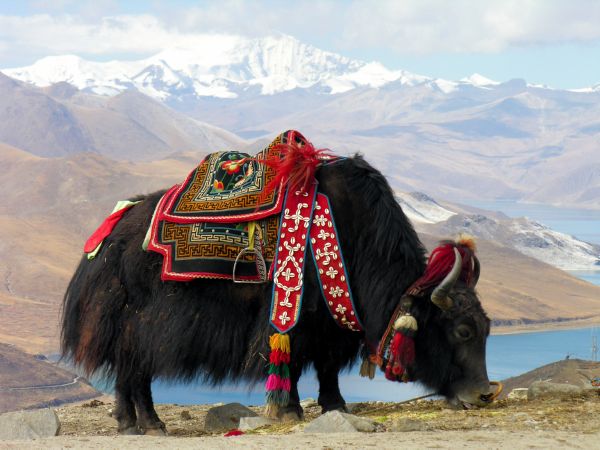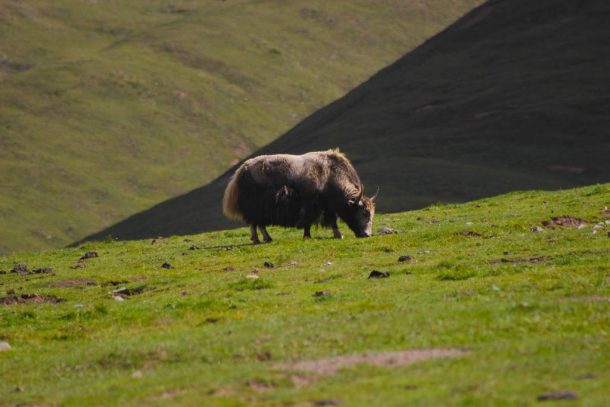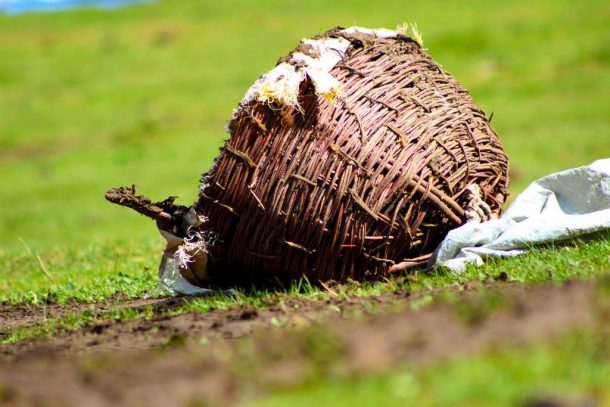The Tibetan Yak – The Backbone of Tibetan Lifestyle in Tibet
When you think of Tibet, most people imagine massive mountains and vast plains, with high lakes spread across the plateau and thousands of monasteries filled with red-robed Buddhist monks. And the ever-present yak. Wherever you go in Tibet, you will find yaks grazing on the pasturelands and beside the rivers and lakes where the grass is at its best. The most of Tibetans are nomads and farmers. For the Tibetan people, there is no animal more important than the yak, as it has provided all the Tibetan people could need in terms of food, clothing, and shelter for more than ten millennia.

The Tibetan yak is a native of the plateau and the Himalayan region, and was first domesticated more than ten thousand years ago by the ancient Qiang people of Tibet, believed to be the first true settlers on the high-altitude plateau. One of the strongest and most hardy animals in the world, the yak has been known to live in the wild at altitudes in excess of 4,200 meters, and this versatile animal has become the backbone of the Tibetan way of life.
Table of Contents
The History of the Yak in Tibet
Yaks are closely related to cattle, and it is widely believed that the original yaks in Southeast Asia may be the ancestors of the North American Bison, which shares many similarities with the Tibetan yak. Diverging from the domesticated cattle around a million years ago, there have been fossilized remains of yak-like bovines discovered all across the Himalayas, stretching as far north as northern Mongolia and even parts of eastern Russia, which gave rise to the belief that the ancestors of the Bison traveled through Russia to get to North America.
Yaks have evolved to live at higher altitudes than normal cattle, and are known to have three times the amount of red blood cells than normal domestic cattle, as well as larger lungs and heart, allowing them to take in more oxygen per breath in the thinner atmosphere at high altitudes. Their long and thick hair has grown out to protect the animals from the harsh cold of the Tibetan winters, where temperatures can drop as low as -30 degrees. Heavy and bulky animals, yaks have a strong frame and sturdy legs, with the typical round cloven hooves of the bovine species. Excellent at clambering over the rough ground and rocky landscape of the plateau, they are the perfect pack animals for Tibetan travelers.
Wild and Domesticated Yaks
In Tibet, the yak has diverged along two distinct paths, though there are few differences between the wild yaks and their domesticated counterparts. Wild yaks are generally black or brown in color, while the domesticated yaks can vary in color, often having patches of lighter brown, white, cream, and grey.

The English word, “yak”, is a derivative of the Tibetan word “g.yag”, which refers only to the male of the species. In Tibet, the female of the species is known as the “dri”, though in English, the borrowed word yak often refers to both male and female, distinguishing them with the use of the terms bull and cow, as in domestic western cattle.
Yak Products
The yak is probably the most important animal in Tibet, and has more uses than domestic cattle in the rest of the world. From head to tail, Tibetans use every part of the yak, many of which are sold or traded as a means of income for most nomadic yak herders.
Horns and Skull
The yak’s horns are often carved into the traditional trumpet-like horns, as well as combs and pipes for smoking, while the skulls can be found across the plateau as a form of traditional decoration.
Yak Hair
There are several different types of hair on an individual yak, and each has its own particular use. The hair from the back of the yak, starting at the spine, is coarse and used to weave the outer fabric of the famous black Tibetan tents used by the nomads across the plateau. As you move further down the animal, the hair becomes softer and can be used for clothing, bags, blankets, carpets, and a whole host of other household items. The yak hair can
Yak Skin
The tough skin of the yak is often used in the Tibetan homes as a cushion or mat to sit on, and when turned into leather, is used to make belts, shoes and boots, and bags for holding food.
Yak Meat
Yaks are the main source of meat on the Tibetan plateau, and while it is similar to beef, the meat is usually a little tougher, with a distinct flavor. Used for most dishes that contain meat, it is often just referred to as beef, and can be found in such dishes as Tibetan noodles and momos, and is dried to make a form of yak jerky.
Yak Tails
The tails of yaks are more like those of horses than western cattle, and are often made in to brooms and dusters for use around the home. More recently, the tails have been used to make decorations for local Tibetan businesses, and can be as long as 80-100 centimeters long.
Yak Dung

Yak dung is collected daily by the Tibetan nomads to use as fuel for fires and stoves. With few trees on the plateau, this valuable source of fuel has become common in Tibet, and is dried and stored to last the entire year. The dung is not as smelly as western cattle dung, just like the yak itself, and when dried, has no foul odor when burned.
Yak Milk
While the milk of the Dri is drunk across the plateau, it is also used to make all of the dairy products for Tibetans, such as butter, cheese, and the famous Tibetan yogurt. These dairy products are used in a variety of ways, including the use of yak butter in the delicious Tibetan Butter Tea.
Yaks as Transport
Yaks are strong animals that ca trek for miles without rest, and are often used as beasts of burden on the plateau. The yaks make a perfect pack animal for the Tibetan nomads as they travel from pasture to pasture around the plateau. In other areas, they are used as plough animals for tilling fields, and can often be found at many of the famous trekking sites to be used for tourist’s packs or for riding around the trek.
Yak Crossbreeds
Yaks have often been bred with domestic cattle from lower altitudes, and while this is possible, the resulting offspring is unique. Hybrid yaks can be found in Nepal, Tibet, Mongolia, and China, and produce the infertile male “dzo” and the fertile female “dzomo”. These crossbreeds have been recorded in China and Mongolia for more than 2,000 years, and the fertile females are often crossbred with domestic cattle again, producing an even weaker yak hybrid that is better suited to lowland life.
Recent Posts
Ultimate Guide to a Mount Kailash Tour in Tibet
The Ultimate Guide to Mount Everest Base Camp in Tibet
Tibet Tour: Discover the Spiritual Side of the Tibet
All Categories
- About Tibet
- book a Tibet tour
- Buddhism Practice
- Budget Tour
- China-Tibet Train
- Customized Tibet tour
- Historical Sites
- Hot Springs in Tibet
- News
- Photography in Tibet
- Tibet attraction
- Tibet Group Visa
- Tibet Motorcycle Tour
- Tibet Small Group Tours
- Tibet Tours and Tibetan Tour Guide
- Tibet Train
- Tibet Travel FAQs
- Tibet Travel Information
- Tibet Travel News
- Tibet Travel Permit Update
- Tibet Travel Prices Rises
- Tibet Trek
- Tibet Trekking Tour
- Tibet weather and climate
- Tibet Wildlife animals
- Tibet Winter Tour
- Tibetan Buddhism
- Tibetan Cultural Features
- Tibetan Culture and Poeple
- Tibetan Festivals
- What to see in Tibet



